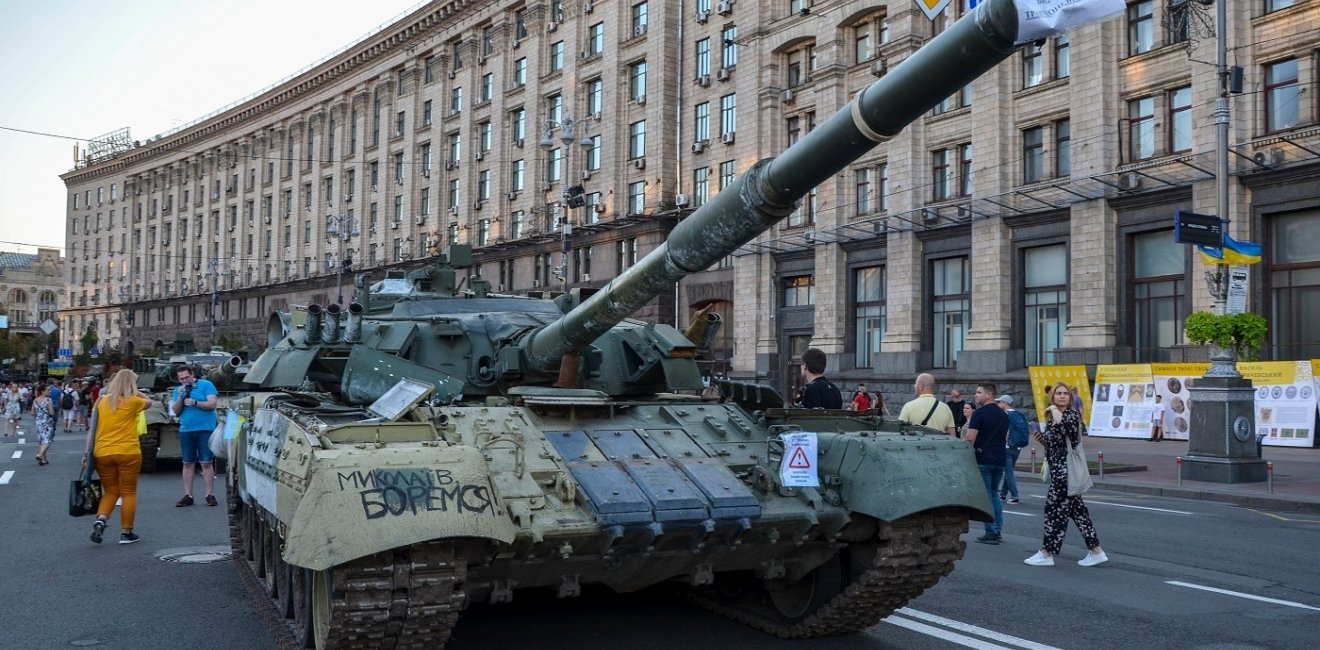
A blog of the Kennan Institute
The Russian invasion of Ukraine was the major event of 2022. Despite the Kremlin’s and Western expectations that Russian forces would achieve a quick victory in Ukraine, the reality proved rather different. After initial success in occupying some northern, eastern, and southern regions of Ukraine, the troops of the Russian Federation were forced to retreat from most of their Ukrainian positions. Still, after ten months of fighting, war crimes, the mass migration of the Ukrainian population, and a serious contraction of the Ukrainian economy, the war goes on.
I asked four experts to assess the results of the Russian war on Ukraine at the end of 2022. What were three main outcomes of the war so far? How will the situation evolve in the first months of 2023?
Hanna Shelest
It is a difficult moment to draw conclusions regarding results. On the one hand, we have already had ten months of war, so enough time has passed and enough data have been accumulated for lesson learning, both politically and militarily. On the other hand, the Russian aggression is at a peak, so the situation still has not passed an inflection point that might suggest a future trajectory.
Nonetheless, as a first outcome we can point to the extreme underestimation both by Russia and by many Western states of Ukrainian capabilities and will to fight. This war is both old-style and innovative, by which I mean that high morale and an understanding of what you are fighting against are no less important than the use of high-tech equipment.
A second outcome is understanding that the “neutrality” concept has changed from its original sense of security guarantees. Sweden and Finland joining NATO, Moldova talking with the UK and Romania about military support—these are clear signals that nobody wants to go it alone in the face of potential, unforeseen aggression.
A third outcome is that Ukraine and the world will not avert their eyes from the atrocities and war crimes committed by the Russian Federation. A lot of mistakes were made after the annexation of Crimea and the occupation of the Donbas in 2014. Today people demand justice in addition to victory. So in 2023, we would definitely expect active steps toward creating a tribunal for this purpose and more work on the attribution of war crimes and compensation mechanisms. But 2023 will also bring continued fighting, at least until the invading forces have been pushed back to the line of control that existed in February 2022.
Tetyana Malyarenko
Most of all, I was struck by the uncompromising nature of Ukrainian society and the willingness to endure hardships for the sake of winning the war. Almost a year has passed, and there is no sign of war weariness, although public opinion polls conducted right before the war showed that no more than 30 percent of the population was ready for armed resistance against Russia. The Ukrainian people found in themselves internal reserves, resilience, and strength, but they also became convinced that the "Russian world" brings suffering and barbarism.
I was both surprised and not surprised by the weakness of Russia's strategic and tactical thinking after 2014. In retrospect, the "hybrid war" approach was not the worst choice for Russia to balance between China and the West and benefit from global infrastructure projects such as the Belt and Road Initiative and Nord Stream. The decision to launch an invasion of Ukraine was suicidal for Russia, and each subsequent decision by the Russian leadership has only worsened Russia's position.
Also worth noting is the consolidation of elites and civil society in the West in support of Ukraine. The West has united, providing military, financial, and humanitarian assistance. The EU has accepted about 9 million Ukrainian refugees. Ukraine has received a real prospect of EU membership, which, of course, is an achievement of the Ukrainian people, but also represents an assessment of this achievement by the Europeans.
Andrew Monaghan
The eruption of intense fighting that accompanied Moscow’s full-scale invasion of Ukraine in February 2022 marked not the beginning but the continuation in a new form of a war already several years old. Nevertheless, 2022 brought to Europe warfare on a scale unseen since the 1940s, and the magnitude of the tragedy has only grown with the escalation of attacks on Ukraine’s critical infrastructure. Thus the first major outcome of the war is the unfolding of an ongoing major, multifaceted, and extended catastrophe in Europe.
Though Ukraine has dealt some severe setbacks to the Russian military, the war is not yet over, so it is not really possible to talk of “outcomes.” Some significant consequences of the fighting appear quite clear, though, including the crystallization of some longer-term structural shifts in the Euro-Atlantic region: Sweden and Finland are conducting NATO accession talks, and Ukraine has been granted EU Candidate Country status.
A second “outcome” is Russia’s isolation from Europe. Russia has long had a dissonant relationship with the Euro-Atlantic community, which manifested in an increasingly systemic competition through the 2010s. Moscow’s waging of war in 2022 converted this competition into a full-scale contest, likely to last well into the 2020s. This is an intense contest in political, economic, diplomatic, and military domains. It is hard to escape the sense that as 2022 drew to a close, an iron curtain had once again settled across Europe.
Another consequence is that the severe setbacks for Russia’s ground forces obliged Moscow to conduct a draft of some 300,000 people to stabilize the front lines. A third significant outcome of 2022, therefore, is that Russia, a nuclear power, has mobilized and moved onto a war footing, with ramifications rippling through its domestic politics and the economy.
Looking ahead to early 2023, Moscow seems likely to conduct intensified campaigning, even a renewed offensive to achieve its aims. Moreover, the confirmation of the broader contest seems likely to be (yet further) codified in an updated version of the Russian Foreign Policy Concept. We should also expect Moscow to conduct active diplomacy to this end, particularly across the Middle East and North Africa.
Stefan Wolff
Among the three main outcomes of the war so far I’d mention first that Ukraine has proven far more resilient than most analysts expected. Not only have Ukrainian forces stopped the illegal Russian land grab, they have also recaptured important territories and inflicted several tactical defeats on Russia.
Second, the Western alliance has demonstrated unity in the face of Russia’s aggression and has been strengthened by the iron-clad commitment of all members to stand up to Russia. Despite some uncertainty over this, both the EU and NATO, and their allies further afield, have not buckled under Russian pressure but have remained committed to supporting Ukraine militarily, politically, and economically while enacting unprecedented sanctions against Russia.
And third, despite recent Ukrainian gains and Russia’s significant international isolation, the tide has not yet decisively turned in Ukraine’s favor. Russia remains a potent and unscrupulous opponent unafraid to break any conceivable international law in pursuit of its nefarious agenda in Ukraine.
With respect to the evolution of the situation in the first few months of 2023, we are likely to see Russia continuing its attacks against critical national infrastructure in Ukraine, aimed at breaking Ukraine’s will to resist. This is unlikely to succeed as long as Western support, both military and economic, keeps flowing to Ukraine. With this support, the country may be able to avoid an even more severe humanitarian crisis.
If Ukraine and the West remain steadfast in their determination to prevent Moscow from pressuring Kyiv and Western capitals into “peace negotiations,” the current stalemate on the ground is likely to continue until the spring. But it is unlikely to take the form of a de facto truce. We are more likely to see more of what has happened over the past few weeks—drone and missile attacks by both sides, artillery and infantry battles along the front lines, and civilian suffering.
As neither side will be able to decisively exit the current stalemate, both will prepare for major offensive operations in the spring. With Western support, especially the delivery of advanced air defense systems, more and more powerful artillery systems and armored vehicles, and possibly more and more capable drones, as well as advanced training for Ukrainian forces, Kyiv will be in a better position than Moscow by the spring, but even that will not automatically ensure a swift Russian defeat.
The opinions expressed in this article are those solely of the author and do not reflect the views of the Kennan Institute.
Authors




Senior Associate Fellow, Royal United Services Institute, London; Non-Resident Associate Fellow, NATO Defense College

Professor of International Security at the University of Birmingham

Kennan Institute
The Kennan Institute is the premier US center for advanced research on Eurasia and the oldest and largest regional program at the Woodrow Wilson International Center for Scholars. The Kennan Institute is committed to improving American understanding of Russia, Ukraine, Central Asia, the South Caucasus, and the surrounding region through research and exchange. Read more

Explore More in Focus Ukraine
Browse Focus Ukraine
Talking to the Dead to Heal the Living

Ukrainian Issue in Polish Elections


